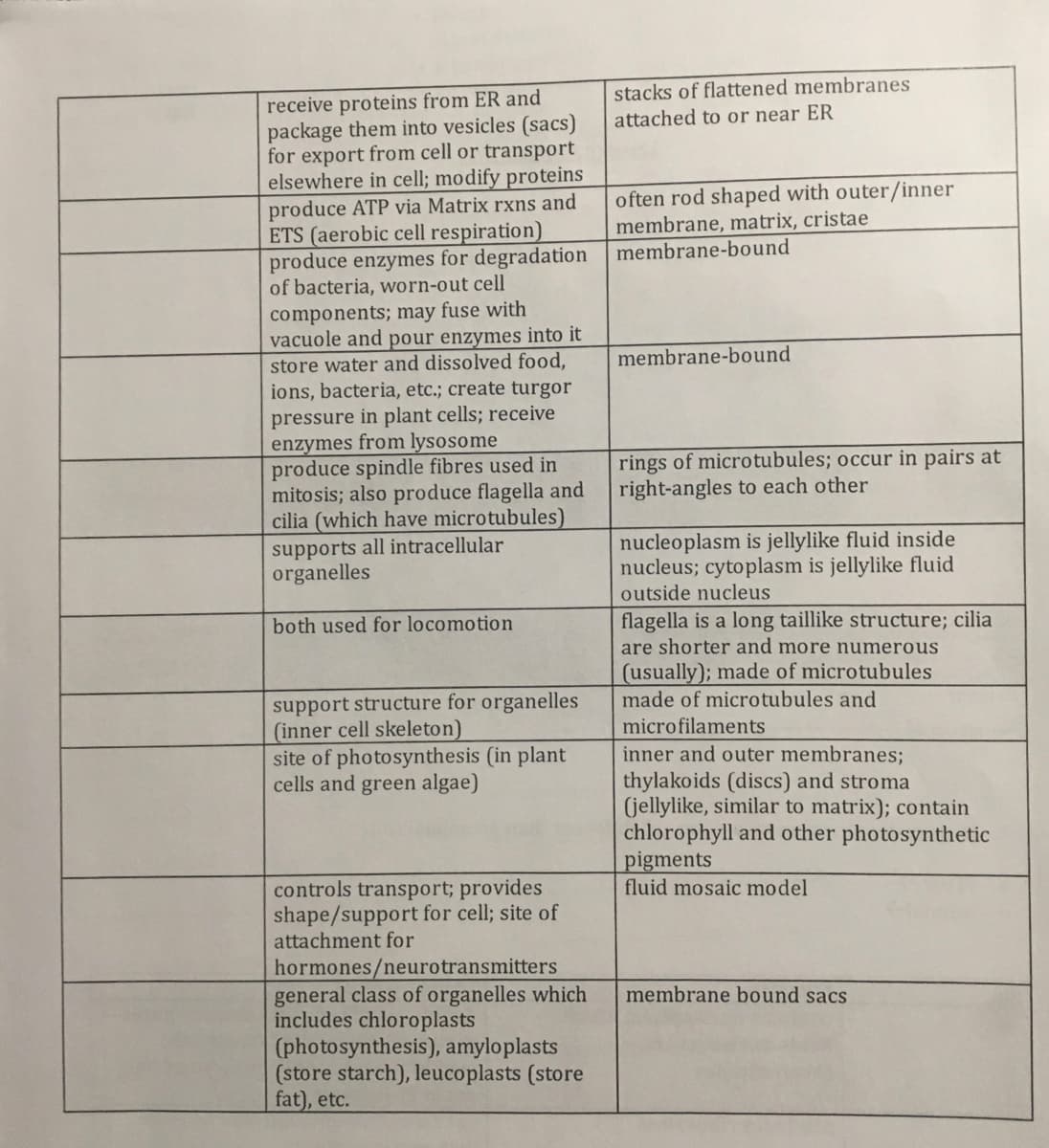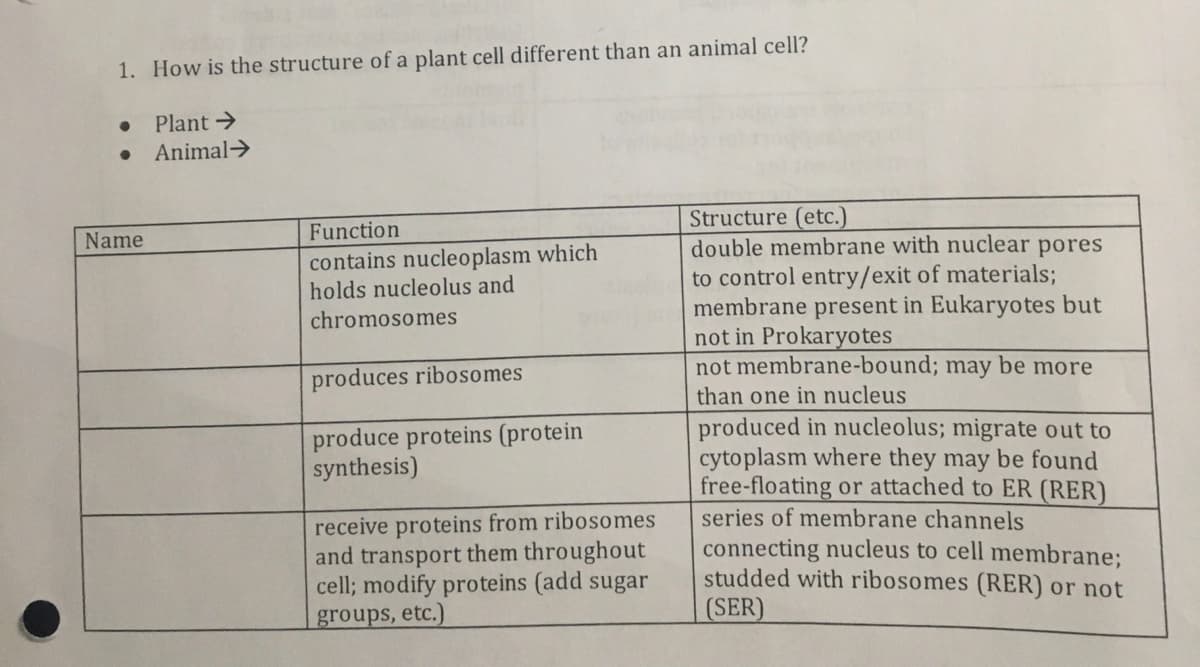stacks of flattened membranes attached to or near ER receive proteins from ER and package them into vesicles (sacs) for export from cell or transport elsewhere in cell; modify proteins produce ATP via Matrix rxns and ETS (aerobic cell respiration) produce enzymes for degradation membrane-bound of bacteria, worn-out cell often rod shaped with outer/inner membrane, matrix, cristae components; may fuse with vacuole and pour enzymes into it store water and dissolved food, ions, bacteria, etc.; create turgor membrane-bound pressure in plant cells; receive enzymes from lysosome produce spindle fibres used in mitosis; also produce flagella and cilia (which have microtubules) supports all intracellular organelles rings of microtubules; occur in pairs at right-angles to each other nucleoplasm is jellylike fluid inside nucleus; cytoplasm is jellylike fluid outside nucleus flagella is a long taillike structure; cilia are shorter and more numerous both used for locomotion (usually); made of microtubules made of microtubules and support structure for organelles (inner cell skeleton) site of photosynthesis (in plant cells and green algae) microfilaments inner and outer membranes; thylakoids (discs) and stroma (jellylike, similar to matrix); contain chlorophyll and other photosynthetic pigments fluid mosaic model controls transport; provides shape/support for cell; site of attachment for hormones/neurotransmitters general class of organelles which includes chloroplasts (photosynthesis), amyloplasts (store starch), leucoplasts (store fat), etc. membrane bound sacs
stacks of flattened membranes attached to or near ER receive proteins from ER and package them into vesicles (sacs) for export from cell or transport elsewhere in cell; modify proteins produce ATP via Matrix rxns and ETS (aerobic cell respiration) produce enzymes for degradation membrane-bound of bacteria, worn-out cell often rod shaped with outer/inner membrane, matrix, cristae components; may fuse with vacuole and pour enzymes into it store water and dissolved food, ions, bacteria, etc.; create turgor membrane-bound pressure in plant cells; receive enzymes from lysosome produce spindle fibres used in mitosis; also produce flagella and cilia (which have microtubules) supports all intracellular organelles rings of microtubules; occur in pairs at right-angles to each other nucleoplasm is jellylike fluid inside nucleus; cytoplasm is jellylike fluid outside nucleus flagella is a long taillike structure; cilia are shorter and more numerous both used for locomotion (usually); made of microtubules made of microtubules and support structure for organelles (inner cell skeleton) site of photosynthesis (in plant cells and green algae) microfilaments inner and outer membranes; thylakoids (discs) and stroma (jellylike, similar to matrix); contain chlorophyll and other photosynthetic pigments fluid mosaic model controls transport; provides shape/support for cell; site of attachment for hormones/neurotransmitters general class of organelles which includes chloroplasts (photosynthesis), amyloplasts (store starch), leucoplasts (store fat), etc. membrane bound sacs
Biology: The Dynamic Science (MindTap Course List)
4th Edition
ISBN:9781305389892
Author:Peter J. Russell, Paul E. Hertz, Beverly McMillan
Publisher:Peter J. Russell, Paul E. Hertz, Beverly McMillan
Chapter4: Cells
Section: Chapter Questions
Problem 6TYK
Related questions
Question
Fill in the blanks of the chart.

Transcribed Image Text:stacks of flattened membranes
attached to or near ER
receive proteins from ER and
package them into vesicles (sacs)
for export from cell or transport
elsewhere in cell; modify proteins
produce ATP via Matrix rxns and
ETS (aerobic cell respiration)
produce enzymes for degradation
of bacteria, worn-out cell
often rod shaped with outer/inner
membrane, matrix, cristae
membrane-bound
components; may fuse with
vacuole and pour enzymes into it
store water and dissolved food,
ions, bacteria, etc.; create turgor
membrane-bound
pressure in plant cells; receive
enzymes from lysosome
produce spindle fibres used in
mitosis; also produce flagella and
cilia (which have microtubules)
rings of microtubules; occur in pairs at
right-angles to each other
supports all intracellular
organelles
nucleoplasm is jellylike fluid inside
nucleus; cytoplasm is jellylike fluid
outside nucleus
flagella is a long taillike structure; cilia
are shorter and more numerous
(usually); made of microtubules
made of microtubules and
both used for locomotion
support structure for organelles
(inner cell skeleton)
site of photosynthesis (in plant
cells and green algae)
microfilaments
inner and outer membranes;
thylakoids (discs) and stroma
(jellylike, similar to matrix); contain
chlorophyll and other photosynthetic
pigments
fluid mosaic model
controls transport; provides
shape/support for cell; site of
attachment for
hormones/neurotransmitters
general class of organelles which
includes chloroplasts
(photosynthesis), amyloplasts
(store starch), leucoplasts (store
fat), etc.
membrane bound sacs

Transcribed Image Text:1. How is the structure of a plant cell different than an animal cell?
Plant >
Animal>
Structure (etc.)
double membrane with nuclear pores
to control entry/exit of materials;
membrane present in Eukaryotes but
not in Prokaryotes
not membrane-bound; may be more
Function
Name
contains nucleoplasm which
holds nucleolus and
chromosomes
produces ribosomes
than one in nucleus
produced in nucleolus; migrate out to
cytoplasm where they may be found
free-floating or attached to ER (RER)
series of membrane channels
connecting nucleus to cell membrane;
studded with ribosomes (RER) or not
(SER)
produce proteins (protein
synthesis)
receive proteins from ribosomes
and transport them throughout
cell; modify proteins (add sugar
groups, etc.)
Expert Solution
This question has been solved!
Explore an expertly crafted, step-by-step solution for a thorough understanding of key concepts.
Step by step
Solved in 5 steps with 3 images

Knowledge Booster
Learn more about
Need a deep-dive on the concept behind this application? Look no further. Learn more about this topic, biology and related others by exploring similar questions and additional content below.Recommended textbooks for you

Biology: The Dynamic Science (MindTap Course List)
Biology
ISBN:
9781305389892
Author:
Peter J. Russell, Paul E. Hertz, Beverly McMillan
Publisher:
Cengage Learning

Biology Today and Tomorrow without Physiology (Mi…
Biology
ISBN:
9781305117396
Author:
Cecie Starr, Christine Evers, Lisa Starr
Publisher:
Cengage Learning

Biology: The Unity and Diversity of Life (MindTap…
Biology
ISBN:
9781337408332
Author:
Cecie Starr, Ralph Taggart, Christine Evers, Lisa Starr
Publisher:
Cengage Learning

Biology: The Dynamic Science (MindTap Course List)
Biology
ISBN:
9781305389892
Author:
Peter J. Russell, Paul E. Hertz, Beverly McMillan
Publisher:
Cengage Learning

Biology Today and Tomorrow without Physiology (Mi…
Biology
ISBN:
9781305117396
Author:
Cecie Starr, Christine Evers, Lisa Starr
Publisher:
Cengage Learning

Biology: The Unity and Diversity of Life (MindTap…
Biology
ISBN:
9781337408332
Author:
Cecie Starr, Ralph Taggart, Christine Evers, Lisa Starr
Publisher:
Cengage Learning


Biology (MindTap Course List)
Biology
ISBN:
9781337392938
Author:
Eldra Solomon, Charles Martin, Diana W. Martin, Linda R. Berg
Publisher:
Cengage Learning

Biology: The Unity and Diversity of Life (MindTap…
Biology
ISBN:
9781305073951
Author:
Cecie Starr, Ralph Taggart, Christine Evers, Lisa Starr
Publisher:
Cengage Learning